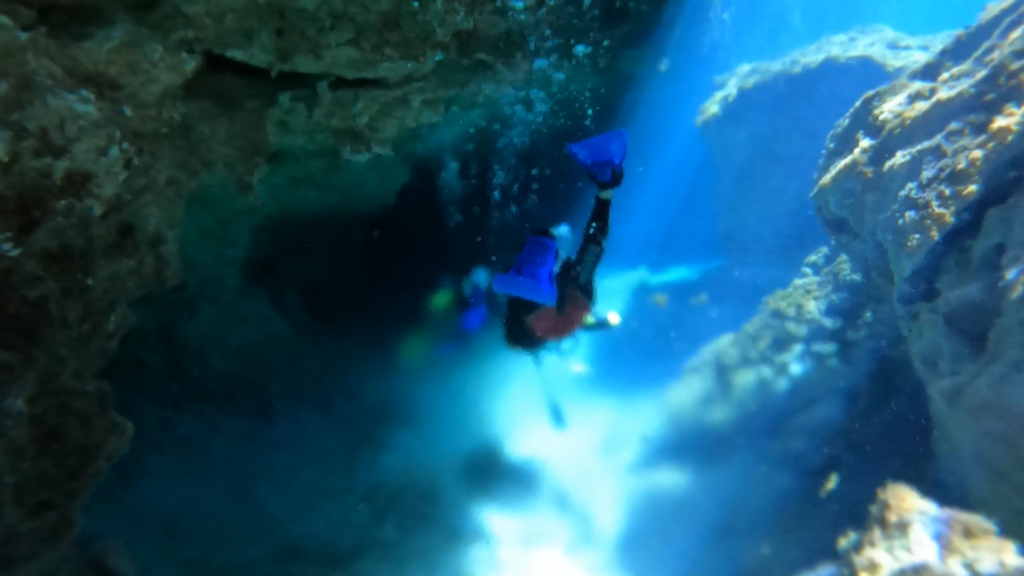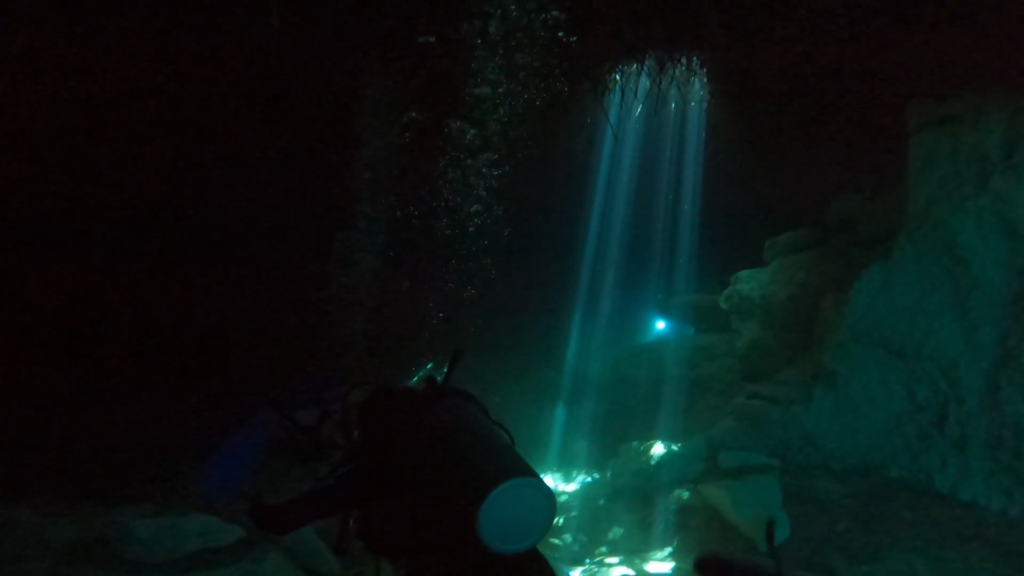The small beach town Tulum on the Yucatán Peninsula has become a famous holiday destination. It has received a lot of social media attention because of its natural beauty including cenotes, dreamy beaches and wild jungle. All of this, together with picturesque restaurants and cafés, creates many Instagram-worthy photo spots in Tulum.
Cenote diving in Tulum is a must for every certified scuba diver. Cenotes are naturally formed sinkholes in the ground that expose ground water. For many years, the cenotes of the Yucatán Peninsula have attracted visitors, among them many scuba divers eager to discover the hidden underwater world. You’ll see impressive rock formations and stunning light spectacles paired with haloclines, the effect of salt water meeting fresh water.
Also the hidden gems of Tulum, such as Kaan Luum Lagoon, are worth visiting if you enjoy exploring places that are off the beaten track.

Table of Contents
Things to know before you go cenote diving
The thought of diving down an underwater cave might be a bit daunting in the beginning if you’ve never done it before. But not all cenotes are dark and narrow caves. There are three different types of cenotes:
- Open cenotes
- Semi-open cenotes
- Cave cenotes
If you have any doubts, start with a wide and open cenote, such as Casa Cenote to get used to cenote diving. Here’s everything you need to know before going cenote diving in Tulum.
Side note: The cenotes Pet Cementary Cenote and Gran Cenote have recently been restricted for divers and you can only dive there if you have a cave diving certification.
Which dive center to book with
There are numerous dive centres to choose from in Tulum. I went with The Mayan Cave and was 100% happy with them. My dive guide was highly professional and we were a small group of only 3 people. Also the equipment was in a great condition. Another well renowned dive centre in Tulum is Koox Diving.
Before you book your dive just make sure to check the online reviews of the agency and only book if you feel safe and comfortable.
Is cenote diving safe?
Yes, cenote diving is safe and there’s no reason to be afraid. Book with a professional agency and they will take good care of you. The dive guides do this on a daily basis and they know exactly what they’re doing. Tell them any doubts you may have and if you’re scared, make sure to start with an easy dive such as Casa Cenote to get used to cenote diving.
Entrance fee for cenote diving
Every visitor of a cenote has to pay an entrance fee that differs from cenote to cenote. Usually, the entrance fee is between five and ten Euros. When you go cenote diving in Tulum the entrance fee will be included in the price of your dive.
Halocline


Haloclines happen when saltwater from the ocean mixes with freshwater. In a halocline the water gets blurry and you can’t see much, which may feel a bit disorientating. It’s like a photo that is out of focus or when you have bad eye sight and you don’t wear your glasses.
In many of the cenotes in Tulum you’ll see the phenomenon of a halocline when going scuba diving. The photo above shows the halocline in Casa Cenote.
Is it worth it to go cenote diving in Tulum?
YES, absolutely!
In case you’re in doubt if cenote diving is the right thing for you, read this – I was there too.
When I visited Tulum for the first time I made the mistake of not going cenote diving because I had believed it wouldn’t be that impressive. Having dived in some of the world’s most famous dive sites in Komodo National Park, I thought diving cenotes could be boring. Not much marine life, no coral reefs – what’s there to see then? “Caves are just rocks and nothing else”, I had thought.
Oh boy, was I wrong. I had seen amazing photos of cenote diving but I wasn’t sure if reality would live up to that.
When I returned to Mexico in 2021 I finally decided to give cenote diving in Tulum a try and I’m incredibly happy that I did.
The photos might look amazing but they don’t do the natural beauty of cenotes justice at all. Being there, seeing the halocline, diving through caves and experiencing the magical view of the light shining through the surface is simply breathtaking.
I dived in about 30 dive sites so far and cenote diving in Tulum – especially Casa Cenote – was one of the most beautiful diving experiences of my life.
Dos Ojos Cenote Dive
Cenote Dos Ojos is one of the most famous cenotes of the Yucatán Peninsula. You need an open water certification to go scuba diving there.
There are two routes for diving cenote Dos Ojos, The Batcave Line and The Barbie Line. If you do only one dive at cenote Dos Ojos, I recommend going for The Barbie Line as it’s more beautiful. There are impressive rock formations and you’ll see stalactites and stalagmites all around you.
Casa Cenote Dive


Casa Cenote is a popular cenote dive for beginners. It’s a shallow dive that allows you to get used to cenote diving in a more open space. It’s also good for a refreshment dive to practice the basics again if you haven’t gone diving in a while.
The dive in Casa Cenote is incredibly beautiful. I was absolutely stunned by the light beams shining through the surface and illuminating the underwater area in a shiny turquoise tone. We even spotted an alligator and some crabs.


El Pit Cenote Dive
Many people say that El Pit is the most amazing cenote dive in Tulum. Unfortunately, I couldn’t make it to El Pit but this dive is still on my list for the next time I travel to Tulum.
If you dive El Pit at around noon, the sunlight will shine through a hole in the ground, projecting stunning light effects into the water. Most importantly, only dive El Pit on a sunny day, otherwise you won’t see the beautiful light beams underwater.
To dive El Pit you need to have the Open Water Advanced certification. The cenote is the deepest in the state of Quintana Roo as it has a depth of over 40 meters.
Angelita Cenote Dive
Diving Cenote Angelita is a stunning and unique experience for advanced scuba divers. What makes Cenote Angelita unique is a thick layer of hydrogen sulphate that separates fresh water from salt water. This cloud of hydrogen sulphate looks so surreal, it makes you feel as if you were in a different world.
Calavera Cenote Dive
Cenote Calavera is close to the town center of Tulum. It’s one of the best dive sites for seeing the halocline. Despite its proximity to the center of Tulum, Cenote Calavera is relatively quiet and not too crowded.
Which cenote to choose for diving?
If you’re only going to do a couple of dives, you might wonder which cenotes to choose for your cenote dive in Tulum. Personally, I recommend Casa Cenote to begin with and then either Cenote Dos Ojos for Open Water divers or El Pit if you’re an Open Water Advanced diver.
But any of the cenotes I mentioned are unique and beautiful in their own way, so just talk to someone from your dive center. They will surely provide you with any information that you need and answer all questions you may have.
I hope this article helps you in planning a memorable trip and inspired you to go cenote diving in Tulum!



Sharing is caring!


February 27, 2021 at 5:00 pm
The cenotes look so gorgeous!! Still haven’t been to Mexico, but I can’t wait to go. The light beams in Casa Cenote are especially cool – and how exciting that you saw an alligator!
March 1, 2021 at 2:41 pm
The nature around Tulum is just incredibly beautiful! Hope you get the chance to go there
February 27, 2021 at 5:14 pm
It would be so cool to dive in any of these cenotes! I’ve visited Tulum, but didn’t explore any of the caves.
March 1, 2021 at 2:40 pm
It also took me 2 visits to Tulum before I tried it out but it’s absolutely worth it!
February 27, 2021 at 7:02 pm
I’ve never seen a cenote in my life. Didn’t know you need to be a certified diver to dive in one but I guess that makes sense. I wonder if you could just snorkel or swim in it instead? Or maybe I should really set about getting that PADI licence soon.
March 1, 2021 at 2:39 pm
You can swim or snorkel in the cenotes too! But scuba diving is another level!
February 27, 2021 at 8:48 pm
What a cool experience Maria! When I visited a cenote during my time in Tulum, I saw a few people scuba diving. I really hope to do this when I return one day. 🙂
March 1, 2021 at 2:38 pm
I hope you get the chance to do it, it’s an incredible experience!
February 28, 2021 at 3:58 am
This looks amazing! I’m really scared of deep water but I’d love to try this
March 1, 2021 at 2:37 pm
It feels like a different world down there!